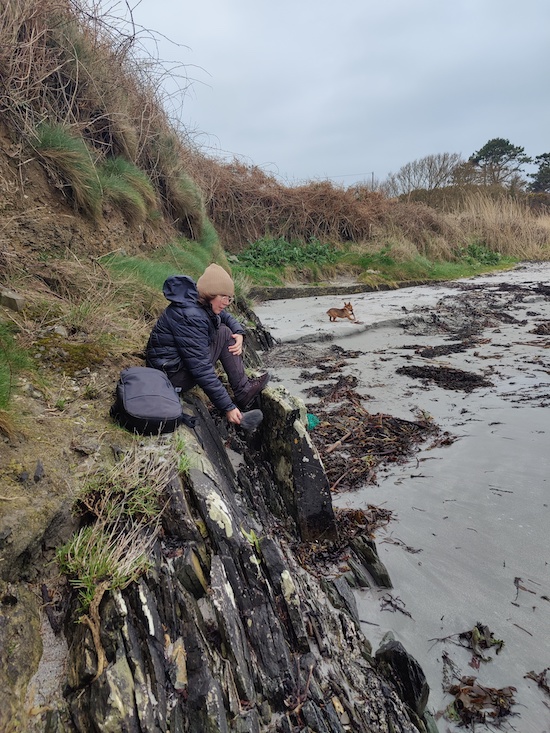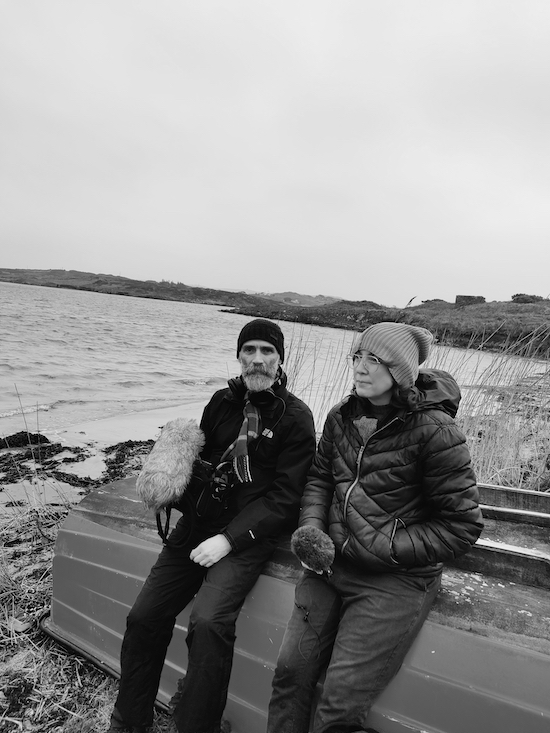Open Ear 2024 is a music festival that takes place on Sherkin Island, in Cork, Ireland. This year they have commissioned artists and field recordists David Donohoe and Kate Carr collaborate on performance for St Mona’s church, where they will improvise a durational performance around a score that incorporates graphics and text, using field recordings, synthesis, foley, live percussion, bird horns, and collected materials from Sherkin. Carr works with field recordings, recording intimate sounds and the broader soundscape, as well as using objects and experimental recording techniques in her composed, performed and installed works. She’s often explored the ambiguities and perceptions of field recording, and has recently been making work using faked bird calls. She is also part of the duo Rubbish Music with Iain Chambers, who build soundscapes from discarded objects, and runs the acclaimed sound art label Flaming Pines. Donohoe is a composer, recordist, artist, performer and improviser who incorporates field recording, percussive and instrumental elements, as well as synthesis and processing. He is a long-term collaborator of photographer Eamonn Doyle and has released on Fort Evil Fruit, Force-Inc, Mille Plateaux, and his own imprint Studiomime, among others. They have known one another’s work for some time, but their recent trip to Sherkin to gather recordings and materials for the commission was the first time they had met and worked together.
Can you tell me a bit about Sherkin?
David Donohoe: Sherkin is one of a series of islands off the coast of West Cork. Those islands have a pretty deep history. There’s been a huge depopulation of the islands over the last 200 years, especially after the 1840’s famine and on into the early 20th century. So they formerly would have been very vibrant communities with a huge emphasis on living from the sea, knowledge of the sea and how it works, in terms of its flows, how to get food from it and work it. But all of that became lost in the post colonial [period]. Once the Republic of Ireland was formed, there was a rejection of what might have been viewed as perhaps ‘peasant’ history, and a desire to be modern. So the islands have vestiges and remnants of the old culture that was there. They’ve become centre points for people who are hanging on, eking out a living, but also people who drop out. There’s a lot of multinational people who try to live self-sufficiently – you get a blend of cultures.
Kate Carr: There are quite a lot of artists as well. We ran into people farming alpacas who were taking them to visit the sea for the first time. It was a mix of very alternative lifestyles. The other thing I thought was interesting was when we heard a folk song written for Sherkin Island. David and a few others were commenting on the libertarian tendencies that were being expressed – this ‘We’ll do things our way’; ‘We’ve got a Sherkin independence and way of doing things’. That was interesting to me.
DD: We were having dinner in the hostel, which is a hub where people come and hang out, so you get this melting pot of whoever the hell is there. A guy stood up and acapella sung the Sherkin anthem, which someone who had recently died had written a few years previously. It was a memorial to the guy who had written it, but also those anthems, if you’re someone visiting it’s charming but there’s also a bit of an underbelly of… threat? They are essentially saying we are ourselves and you are other, you know? There’s a sense of being alternative to, or in rebellion against the mainland to a degree, so they are these little kingdoms to themselves.
I sound like I’m being negative – I’m not, you just get that kind of fierce independence in Ireland; an interesting kind of independence made up of lots of different types of people. Once you go there you’re part of it, but people’s origin from everywhere. It has a really nice vibe. With depopulation, Sherkin feels to me like one of those places where if it didn’t have so many visitors or tourism, it would be much more dead than it is – I could be wrong – I’ve been on plenty of the islands around Ireland which are completely depopulated and they’re just empty. But Sherkin it has loads of vibrance: it has an art college, a hotel currently being used as an Ukrainian refugees, which is another interesting thing, because a whole bunch of Ukrainians came into the drinks and dinner and were singing their songs, too. It’s also beautiful: extremely bleak in winter and extremely beautiful in summer, like lots of coastal places.

Can you tell me a bit more about the church where you’ll be performing or installing work?
KC: It’s a functioning church – not deconsecrated – so that means we have to work with structures that are used all the time for worship, and be very respectful in the ways we’re using its different facets. What we’ve mainly been doing is testing transducers on the wooden aspects of the church – so there’s some plinths above the congregation that we’re experimenting with, using the transducers to turn them into speakers. We’re also looking at some steps that lead up to the altar and turning them into resonating speakers, too. Bird calls and seagull calls actually sounded amazing through the different wooden structures.
So you used a transducer to play sounds through the wooden architecture of the church?
KC: Exactly. We have narrowed our ideas to thinking through wind and stone as starting points, because that was all around us. We’ve been experimenting with those sorts of sounds, the birds, the air, the wind. I used a geophone along some stone fences, drawing up really deep stone-grinding sounds and then seeing how they will resonate within the church structure.
DD: Our guiding approach was to think about how in an island context you’re always subject to and really aware of weather in all its forms. The church would historically be a building of shelter and sanctuary and worship, so as a principal we’re interested in inverting that. We will bring the weather into the interior, as this idea of charging the interior with the energy of the exterior.
Geophones pick up very low vibrations, is that right?
KC: It’s a similar system to a contact mic – the way I usually explain it to people is that it’s like a contact mic, but recorded a lot deeper.
DD: The component parts of it are derived from stuff used for seismic recording. I didn’t actually use one on Sherkin, but we were talking about it as an instrument. It’s pretty unwieldy because it’s so sensitive making it very unpredictable. That’s what’s great about it – it’s amazing how much low frequency you get from places you don’t think will have any.
Are you also collecting materials from the site to use?
KC: Lately I’ve been really into making rattles out of different rubbish items for my Rubbish Music work, but maybe on Sherkin I’ll try and make them out of seaweed. Outside there are also stone slabs, so we’ve been talking about setting up a little stone sounding station for part of the performance. Maybe grass as well – some dried grass – we got some really good recordings of dried grass.
Are you scoring things? What’s the balance between structured and then improvised elements?
KC: We just started writing a score, to structure the movement of the piece around the idea of waiting for a storm, and its aftermath. What sounds build in intensity towards the breaking of the storm? What sounds become less prevalent as the storm approaches? And then similarly, after the storm – what sounds fade away and what sounds come back?
DD: The danger with displaying a score is that you set up expectations for an audience – it can be beneficial, but also detrimental if they’re following along and expecting what’s next. We’re leaving ourselves open to improvisation, so there’ll be a centrally fixed spine in terms of a composition but then we can give ourselves lots of space for improvisation.
Is there anything in your own work as individuals that has a particular resonance with this project?
KC: One interesting thing for me has been Foley practices around the making of the sounds of wind – I’ve found a couple of homemade instruments. One looks a little bit like a kind of kite but with no backing. KC: As a field recordist, sometimes you’re just there to provide the recordings and then people improvise with their instruments within that. Whereas with David and I, we recorded very, different things – I only worked with the contact mics and the geophones, so I really only gathered recordings of vibrations, whereas David did the complete opposite and just worked with regular mics. So we will have very different materials when we pass them over.
DD: I’m used to collaborating and improvising with people, but it’s the first time within an actual field recording project where both participants are providing field recordings. We all have our own methods and practices around field recording, and even post-recording and what we do with our material afterwards. Usually I just know, even mentally in scope, what all the recording will be or in terms of instrumentation what I may use. But I haven’t heard Kate’s recordings yet and Kate hasn’t heard mine, so there’s this unknown quality, which is fundamentally someone else’s reading of that same space.
Open Ear takes place from 31 May to 2 June on Sherkin Island, County Cork, Ireland. for more information, please visit the festival website


